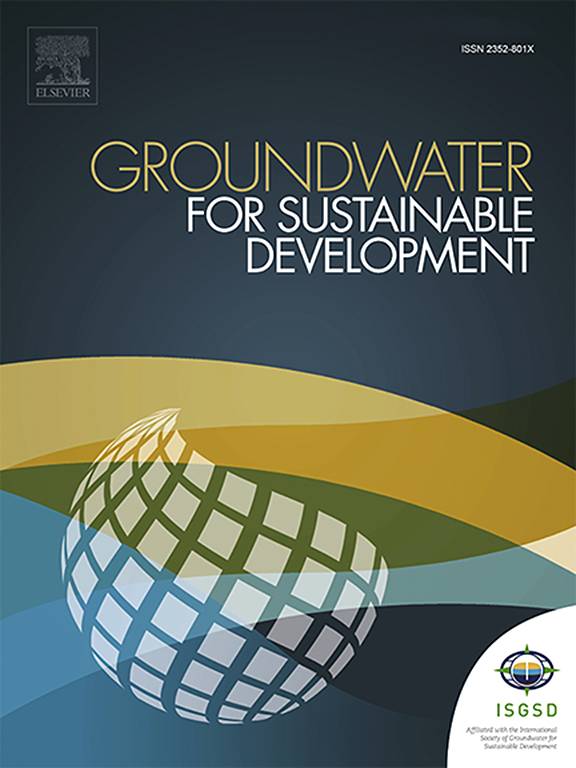Field in-situ push-pull test for enhancing bioremediation of total petroleum hydrocarbons in coal-tar-contaminated aquifers using dual electron acceptors
IF 4.9
Q2 ENGINEERING, ENVIRONMENTAL
引用次数: 0
Abstract
This study evaluates the effectiveness of in-situ bioremediation in a coal-tar-contaminated aquifer using the simultaneous injection of oxygen and nitrate as electron acceptors (EAs). We assessed the removal of total petroleum hydrocarbons (TPH) and total organic carbon (TOC) under varying redox conditions through field single-well push-pull transport tests (SWTT) and a single-well push-pull activity test (SWAT). In SWAT experiments, where microbial activity was emphasized, TPH removal reached 5.7 g in the oxygen-only condition and 44.2 g in the oxygen and nitrate-amended condition, demonstrating a significant enhancement in degradation with nitrate supplementation. Corresponding CO2 production was 402 mmol and 3,120 mmol, respectively, indicating greater microbial respiration in nitrate-amended conditions. The removal of TPH per mole of electron acceptor was 37 mg TPH/mmol O2 and 7.9 mg TPH/mmol NO3−-N, highlighting oxygen's superior efficiency per unit but nitrate's advantage in sustaining long-term degradation due to its greater solubility and availability. Microbial community analysis demonstrated a significant shift in dominant species, with Pseudomonas stutzeri prevailing after nitrate injection, indicating its critical role in nitrate reduction and hydrocarbon degradation. These results highlight the advantages of a dual-electron-acceptor approach, where oxygen facilitates rapid aerobic degradation while nitrate sustains long-term contaminant removal in oxygen-limited environments. Integrating both electron acceptors presents an effective in-situ bioremediation strategy for degrading complex organic contaminants in groundwater.

双电子受体增强煤焦油污染含水层中总石油烃生物修复的现场原位推拉试验
本研究评估了同时注入氧气和硝酸盐作为电子受体(EAs)对煤焦油污染含水层进行原位生物修复的有效性。通过现场单井推拉输送测试(SWTT)和单井推拉活动性测试(SWAT),我们评估了不同氧化还原条件下总石油烃(TPH)和总有机碳(TOC)的去除效果。在强调微生物活性的SWAT实验中,纯氧条件下的TPH去除率达到5.7 g,氧加硝酸盐条件下的TPH去除率达到44.2 g,表明添加硝酸盐显著增强了降解。相应的CO2产量分别为402 mmol和3120 mmol,表明硝酸盐修饰条件下微生物呼吸作用更大。每摩尔电子受体的TPH去除率为37 mg TPH/mmol O2和7.9 mg TPH/mmol NO3−-N,这表明氧气的单位效率更高,但硝酸盐由于其更大的溶解度和可用性,在维持长期降解方面具有优势。微生物群落分析显示,注射硝酸盐后,优势种发生显著变化,stutzeri假单胞菌占优势,表明其在硝酸盐还原和碳氢化合物降解中起关键作用。这些结果突出了双电子受体方法的优势,其中氧气促进了快速的好氧降解,而硝酸盐在氧气有限的环境中维持了长期的污染物去除。结合两种电子受体为地下水中复杂有机污染物的原位生物修复提供了一种有效的方法。
本文章由计算机程序翻译,如有差异,请以英文原文为准。
求助全文
约1分钟内获得全文
求助全文
来源期刊

Groundwater for Sustainable Development
Social Sciences-Geography, Planning and Development
CiteScore
11.50
自引率
10.20%
发文量
152
期刊介绍:
Groundwater for Sustainable Development is directed to different stakeholders and professionals, including government and non-governmental organizations, international funding agencies, universities, public water institutions, public health and other public/private sector professionals, and other relevant institutions. It is aimed at professionals, academics and students in the fields of disciplines such as: groundwater and its connection to surface hydrology and environment, soil sciences, engineering, ecology, microbiology, atmospheric sciences, analytical chemistry, hydro-engineering, water technology, environmental ethics, economics, public health, policy, as well as social sciences, legal disciplines, or any other area connected with water issues. The objectives of this journal are to facilitate: • The improvement of effective and sustainable management of water resources across the globe. • The improvement of human access to groundwater resources in adequate quantity and good quality. • The meeting of the increasing demand for drinking and irrigation water needed for food security to contribute to a social and economically sound human development. • The creation of a global inter- and multidisciplinary platform and forum to improve our understanding of groundwater resources and to advocate their effective and sustainable management and protection against contamination. • Interdisciplinary information exchange and to stimulate scientific research in the fields of groundwater related sciences and social and health sciences required to achieve the United Nations Millennium Development Goals for sustainable development.
 求助内容:
求助内容: 应助结果提醒方式:
应助结果提醒方式:


